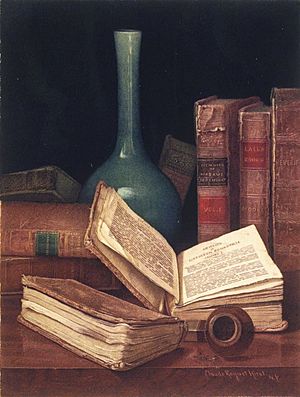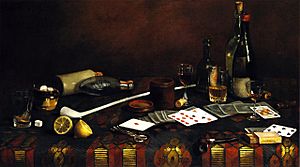Claude Raguet Hirst facts for kids
Quick facts for kids
Claude Raguet Hirst
|
|
|---|---|

The Bookworm's Table, c. 1890
|
|
| Born | November 1855 Cincinnati, Ohio
|
| Died | 1942 |
| Nationality | American |
| Known for | Painting, wood carving |
|
Notable work
|
A Gentleman's Table |
| Movement | Watercolor, trompe-l'œil |
| Spouse(s) | William C. Fitler (m. 1901) |
Claude Raguet Hirst (born Claudine, 1855–1942) was an American painter. She was famous for her still life paintings. A still life shows objects that don't move, like fruit or books. Claude Hirst was special because she was the only woman of her time to become well-known for using the trompe-l'œil technique. This French phrase means "fool the eye." It's a painting style that makes flat objects look like they are real and three-dimensional.
Contents
Early Life and Art Training
Claudine Hirst was born in Cincinnati, Ohio in November 1855. She was the older of two daughters. When she was seven, her family moved to Clifton, a rich area with many artists. Claude started painting lessons when she was just ten years old.
Learning to Carve Wood
In 1874, Hirst joined the McMicken School of Drawing and Design. There, she learned about three-dimensional drawing and wood carving. Her artwork was shown at a big event in Philadelphia in 1876. After leaving school in 1878, she taught wood carving. She even helped carve a fancy screen for the organ at Cincinnati's Music Hall.
Changing Her Name
Around the 1870s, Claudine started using the name "Claude." She might have done this to avoid problems that many women artists faced back then. Using a man's name could help her art be taken more seriously.
Moving to New York City
By 1880, Claude Hirst moved to New York City. Many artists went there hoping to find training, work, and fame. Her mother and sister soon joined her. Claude rented an art studio in Greenwich Village. There, she became friends with a landscape painter named William Crothers Fitler. They got married in 1901.
Developing Her Style
In New York, Hirst taught art and took private lessons from other artists. She joined important art groups like the American Watercolor Society. She showed her still life and watercolor paintings in New York and other cities. At first, her still lifes often showed fruit and flowers, especially pansies and roses.
During the 1880s, Claude Hirst's painting style became very precise. Her brushstrokes were so smooth that you could barely see them. This helped her create very realistic paintings.
Mastering Trompe-l'œil
Hirst began to use the super-realistic trompe-l'œil technique. She started painting objects often found in a man's study or office. These "bachelor still lifes" included things like books, candles, newspapers, and pipes. She painted many still lifes of pipes and tobacco. A rich sugar businessman, H.O. Havemeyer, even bought one of her paintings.
Hirst's Unique Art Style
Claude Hirst was one of the few women to use the trompe-l'œil style during the Victorian Era. People sometimes called her "the female Harnett," comparing her to another famous trompe-l'œil artist, William Harnett.
Inspiration for Her Paintings
After 1890, Hirst stopped painting flowers. She spent the rest of her career painting scenes of library tables. She once explained how she got the idea for these paintings. She said her husband, William Fitler, was not very tidy. His tobacco things were always around. One day, she noticed how nice they looked together. He had a pipe that was a beautiful color, like old ivory. Claude also loved old books and engravings. So, she put the pipe with some of her old books and painted them.
A Gentleman's Table
One of Hirst's famous works from the 1890s is A Gentleman's Table. This painting shows typical objects you might find on a man's table. It includes pipes, bottles, glasses, and playing cards. Her paintings make these everyday items look incredibly real.


